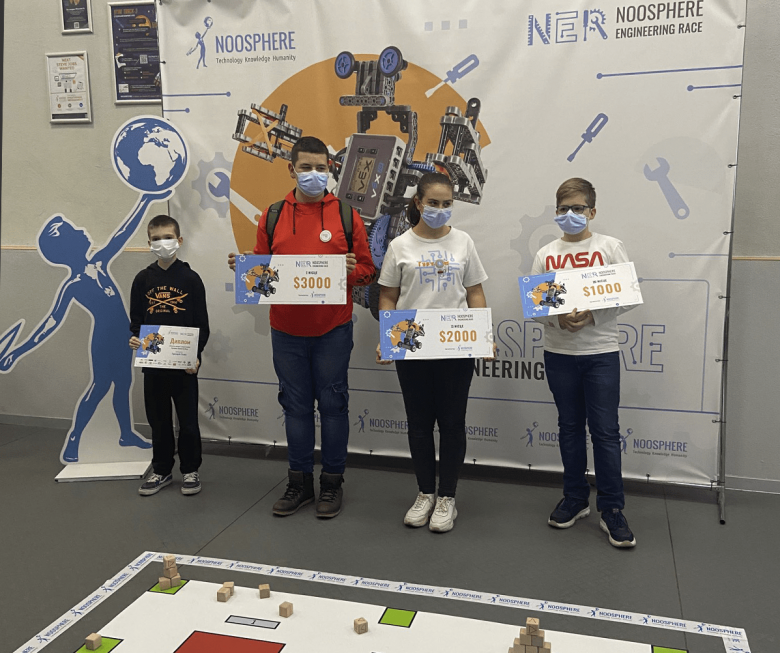For 3 months — from September 15 to December 18 — schoolchildren from Dnipro squared off in design and programming. The competition with a prize fund of $6,000 is a continuation of a series of Noosphere initiatives aimed at promoting science among young people, as well as involving children in engineering. This is the first such competition to be held in Ukraine.
About 400 participants aged 7 to 16 joined the Noosphere Engineering Race (NER). The competition was divided into three stages.
During the first stage, participants had to solve a puzzle that encrypted the word “robotics”. The 100 best scholars made it to the second round.
The second phase of the Noosphere Engineering Race was more complex and required participants to use an engineering approach and technical skills. In a special simulator, students created virtual robots and programmed them to perform three tasks. The first task, nicknamed “Snowflake” was to have the robot reproduce a snowflake pattern as accurately as possible. The second, “Demolition” was to eject the maximum number of objects from the playing field, while the third task was to move game chips to colored areas. During the second stage, working with mentors and experts from Noosphere Engineering School we conducted 2 master classes on the basics of robotics. For many, the NER was not only their first VEX-competition, but also their very first robotics competition.
“This is my first time taking part in robotics competitions. I was very limited in time, preparing for school exams. I only had 3-4 days to prepare,” smiles finalist Denys Poslavskyi. “I would call these competitions Races Against Time”.
11 participants went on to the third stage, and we presented a VEX IQ constructor to each of them. These were more than just prizes, however. The students used these kits to construct and program their final robots.
“This was my first external competition. Before this, I only worked with robots in classes. It was more difficult to design a system than to program it,” says participant Dmytro Ivanchenko.
Participants had three weeks to prepare for the final competition. We actively coached them along and continued to study VEX-robotics together: we shared useful materials, software, etc. At weekly webinars, NER Chief Judge Maksym Slodzik spoke about the basics of VEX IQ design and programming. These webinars were open to everyone, not only the finalists.
“This was my first experience with VEX robotics,” said Kyrylo Blahodarov, a regular participant in BestRoboFest and one of the NER winners.”The last NER webinar helped me really understand robot programming. In general, I liked the competition and of course, I plan to participate next year.”
The final was held on December 18. The competitors had to program constructors to progress through all the zones on the competition field we had prepared, and used cubes to create buildings or even whole cities. As always, we just had to have innovative approaches. This time, we decided to combine the finalists into teams. This meant they both collaborated and competed at the same time, and judges had the opportunity to evaluate not only design decisions and strategy building skills, but also teamwork skills. The task of each round was to work together to score the most points. The fight was fierce, but the winners were the top three design engineers, who shared a $6,000 prize pool:
Yavorskyi, Denys — $3,000
Komar, Anastasiia — $2,000
Blahodarov, Kyrylo — $1,000
“It was very unusual to use a new constructor, with different connections and equipment details. But it was very interesting,” recalls Hryhorii Halik, who took an honorable 4th place.
This is not the first robotics competition experience for Noosphere, as we have been organizing BestRoboFest, a large-scale robotics festival, for five years. We are delighted to be a trend-setter in this area in Ukraine, introducing the local community to world trends. The local Noosphere Engineering Race has demonstrated that there is a strong demand in the robo-community for new competition formats that combine elements of education and training. It was also interesting for the participants to master the new VEX constructor, which is easy to use because it does not require additional tools. Therefore, in the near future we see the scaling of the NER project to the national level.
“We see our goal at Noosphere as ensuring that Ukrainian students not only join world trends, but also lead the rankings of all existing international robotics competitions,” says Max Polyakov.
